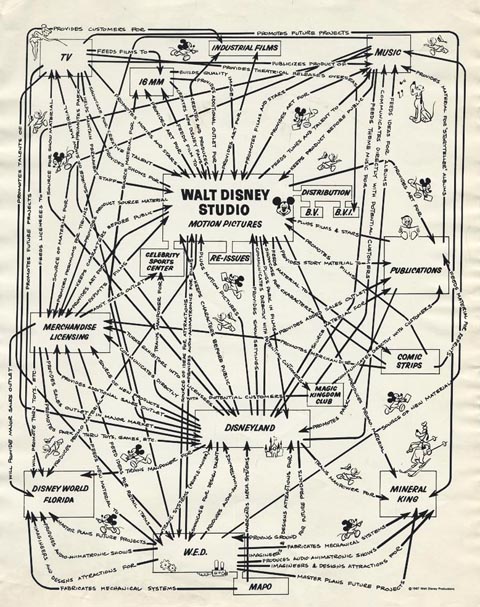The Way Things Are Done At Disney
The Way Things Are Done At Disney

The image on this page is from a diagram that was drawn in 1967 on an 11 x 17 inch sheet of paper. The drawing is an outline of all of the integrated components of the Walt Disney Company. Although Disney died in 1966, the diagram reflects his vision for the company that he built into a business empire.
I saw the diagram for the first time earlier this month at a marketing conference that I attended. It was shown to everyone at the conference during a presentation that was given by Dan Kennedy, a well-known business strategist and marketing expert. The reason Kennedy showed the diagram was to demonstrate how masterful Disney was at building complex systems to attract new customers and to better serve existing customers.
The entities shown in the diagram were all set up by Disney to promote the products and services of all the other entities, and to circulate customers in such a way that the customers would repeatedly do business with the various entities. Kennedy emphasized the fact that while most business owners do their best to avoid complexity in their businesses, Walt Disney did the opposite by embracing complexity, which had the effect of completely marginalizing his competitors.
Kennedy pointed out that in today’s highly competitive, underperforming economy, it is virtually impossible for a business to rise above the competition unless the business develops complex systems that consistently and predictably produce superior products and services.
There is a common belief among most people that complexity should be avoided at all costs and that they should be able to solve their personal and business problems with simple solutions. While simple problems can sometimes be solved with simple solutions, complex problems cannot be solved with simple solutions. Complex problems require complex solutions.
For example, the person who knows he needs to lose 30 pounds is attracted to an advertisement that shows color pictures of tempting foods and desserts. The ad claims that he will be able to melt off the pounds if he takes a few pills each day, drinks some great-tasting shakes, or uses a new exercise machine. Of course, the promise of a simple solution for the complex problem of losing weight is a lie. We all intuitively know this, but most of us allow ourselves to be sold on the idea that there is a “magic pill” out there that will help us easily lose weight and keep it off.
Losing weight is both difficult and complex. At the age of 57, the only way I am able to lose weight is by (1) developing the burning desire and determination to weigh myself every morning, (2) recording my weight on a daily calendar, (3) recording everything I eat on the calendar, (4) cutting back drastically on my intake of bread, carbohydrates, and anything with sugar in it, (5) refraining from eating after 8:00 p.m., (6) visualizing what I will look and feel like after I lose the weight, (7) exercising every day, (8) recording my daily exercises on my calendar, and (9) reviewing the previous week’s meals each Sunday so I can determine what I need to do to adjust my food intake the following week. I wish there were a “simple solution” to losing weight, but there isn’t. Wishful thinking can be dangerous and destructive.
The typical small business owner believes that there should be a simple solution to his inability to attract a consistent flow of new customers to his business. While he intuitively knows that attracting new customers is extremely difficult, he has an unreasonable expectation that a flood of new customers will appear at his door to pay him money if he places an advertisement, runs a few radio commercials, or sets up a website. It’s not that simple. Walt Disney knew better. He understood what it took to not only attract new customers, but to get them to keep coming back.
So here’s my question for you: Is the way to Heaven simple or complex?
While we desperately want to believe that the pitiful amount of time we spend each day praying is going to get us into Heaven, we are sadly mistaken. Do you know how the saints got into Heaven? They did the equivalent of what Disney did. They had several things they were doing simultaneously within a “holiness diagram” that were synergistic (similar to what Disney had in his diagram). Among other things, the boxes in their diagram included daily prayer and devotions, daily works of mercy, and daily acts of humility and mortification.
My current holiness diagram has a box for daily prayer that includes Mass, a Rosary, and a holy hour in the adoration chapel. My time in the chapel consists of spiritual reading, writing, and prayers that include the Divine Mercy Chaplet, Litany of Humility, and devotion to the Seven Sorrows of Mary.
My second box consists of my weekly Adoration Letter and my monthly Adoration Meditation.
My third box includes my interaction with family members, friends, and clients where I incorporate various works of mercy, some of which include instructing the ignorant, counseling the doubtful, admonishing sinners, bearing wrongs patiently, forgiving offenses willingly, comforting the sorrowful, praying for others, and providing free legal services to those who are in desperate need.
A fourth box that is planned for the future will include the development and publication of various websites, videos, CDs, and books that promote the Catholic faith, perpetual adoration, and special devotion to our Lord and our Lady. Additional future boxes may also include a charitable foundation and a mentoring program for young Catholics.
Now here’s my second question for you: What does your holiness diagram look like?




2 Comments
DEAR HARRY AND GEORGETTE –
HAVING A DEAR FRIEND – AND FORMER STUDENT, LOIS – IN CALIFORNIA WHO HAS WORKED FOR DISNEY LAND FOR THE PAST 30 YEARS, WITH WHOM I HAVE KEPT IN CLOSE CONTACT SINCE HER HIGH SCHOOL DAYS, I FOUND YOUR PICTURE AND EXPLANATION MORE THAN INTERESTING! I LOVE THE WAY YOU WEAVE PRECIOUS STORIES INTO PRESENTING INCENTIVES TO GROW IN HOLINESS! I’VE NEVER THOUGHT OF “BOXES”, BUT DO HAVE SPECIAL PRAYERS FOR MY DAILY CONTEMPLATION!!! I WILL BE CALLING LOIS’ ATTENTION TO YOUR ARTICLE!!!
LOVE, SISTER ROBERTA
Harry, not quite on your main point, but there may be an easier way to lose weight which incorporates what you probably already are doing: fasting. When my brother Rick had open heart surgery, I came across this great book, The Alternate Day Diet, which really has a simple premise: eat less 3 days a week. For me, figuring that I didn’t put on pounds overnight, so I shouldn’t expect to lose them that way either, I just followed the lenten fast rule of two small meals that do not add up to more than one meal, then a regular meal, effectively skipping a meal three days a week, such as Monday, Wednesday, Friday or Monday, Thursday, Saturday, whatever. It works.